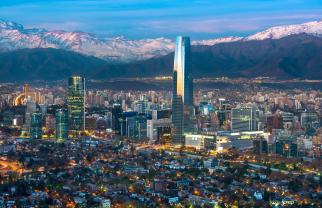Chile: Cost of Living

July 16, 2019
By GoinGlobal
Introduction
Chile is one of South America’s most stable nations with one of the region’s most prosperous economies. It is considered among the most competitive economies in Latin America, thanks to its strong institutional structures. Chile’s efficient government actions have guaranteed low public debt and market stability in the last decade. Over the past 15 years, Chile has enjoyed one of the fastest-growing economies in the region, with an average annual growth of almost 5% between 2003 and 2013. Since 2005, the country’s per capita gross domestic product (GDP) has doubled, reaching a current value of 24,000 USD.
Chile also weathered the global recession thanks to a diversified financial system and solid regulatory framework. However, due to a drop in copper prices (Chile is the world’s first exporter of this metal, and copper represents 20% of the government’s revenue), the country has recently entered an economic slowdown. Annual GDP growth fell from a high of 6.1% in 2011 to 1.6% last year, which has also caused higher inflation and the depreciation of the national currency (the Chilean peso, or CLP). While the forecast for this year’s economic progress is moderate, Chile’s future looks promising, with expected economic growth averaging 4% in the coming four years.
Chile is today the fifth-largest economy in South America, and it was the first South American country to join the Organisation for Economic Co-operation and Development (OECD), which took place in May 2010. Thanks to its strong economy, Chile boasts high incomes and is a highly developed country.
Despite this positive context, 15% of Chileans still live in poverty, and inequality levels are among the highest in the OECD. The current government is focusing on implementing constitutional and fiscal changes, as well as social reforms, in order to tackle inequality and to promote education and health care for all. However, the recent economic slowdown and unprecedented scandals of corruption over the electoral campaigns of current president Michelle Bachelet are causing the delay in the implementation of these structural and social reforms.
More than 40% of the country’s population lives in and around Santiago, the capital (also known as Santiago de Chile). Other important urban centers include the metropolitan areas of Concepción, Valparaíso, La Serena and Antofagasta.
While Chile is relatively more expensive than other Latin American countries, the country is cheaper when compared to other industrialized nations.
-
On average, consumer prices in Chile (excluding rent) are around 31% cheaper than in the US.
-
In general, consumer prices in the country, including rent, are almost 50% higher than in Mexico.
-
Santiago is an affordable capital by international standards and, in fact, does not appear in any of the major rankings of the world’s top 50 most expensive cities.
-
Chile’s capital represents the 67th most expensive city in the world for foreign residents, according to Mercer’s latest global cost of living ranking, which compares 209 world cities.
-
When comparing the average cost of living of foreigners, life in Santiago is 55% cheaper than in New York City.
-
The same living standard in Valparaiso, the third-largest urban area in the country, can cost nearly 64% less than in New York City.
-
Consumer prices in Concepción, the second-largest city in Chile, are almost 52% cheaper than in Paris. This means that the same lifestyle that would cost 4,400 EUR per month in Paris (including rent) would cost a foreign resident in Concepción approximately 2,116 EUR per month.
Average Prices
Chile has a relatively high cost of living compared to other countries in the region. However, basic services, locally sourced food and transportation are less expensive than in developed countries. Street foods, especially fruits and vegetables, are cheap, while manufactured goods, which are often imported from North America or Europe, are more expensive.
The capital, Santiago, is generally more expensive than other areas of the country. While the cheapest town in the country is Rancagua, the urban areas of Antofagasta, Valparaíso, Temuco and Concepción follow the capital as the most expensive cities in the country, according to recent data by the National Institute of Statistics (INE).
Average Prices for Select Goods and Services in Santiago and Valparaiso (in CLP)
|
|
Santiago |
Valparaiso |
|
Groceries |
|
|
|
Tomatoes, 1 kilogram |
998 |
840 |
|
Apples, 1 kilogram |
915 |
589 |
|
Potatoes, 1 kilogram |
727 |
672 |
|
Domestic beer from a supermarket, 0.5 liter |
1,033 |
735 |
|
Good-quality table wine, one bottle |
4,673 |
3,567 |
|
Toilet paper (four rolls) |
2,066 |
1,282 |
|
Cold medicine (six-day treatment) |
2,880 |
2,475 |
|
Dining out/entertainment |
|
|
|
Daily lunch menu, including a drink (business district) |
5,967 |
4,565 |
|
Dinner for two, including wine and dessert, at an Italian restaurant |
33,941 |
26,868 |
|
Beer in a pub |
2,902 |
2,172 |
|
Pair of cinema tickets |
8,187 |
7,616 |
|
Clothing |
|
|
|
Summer dress from an international-brand store |
21,247 |
30,529 |
|
Pair of jeans |
36,652 |
35,539 |
|
Pair of international-brand sport shoes |
44,029 |
43,787 |
|
Services/fees |
|
|
|
One month of gym membership (business district) |
29,567 |
32,398 |
|
Transportation |
|
|
|
1 liter fuel |
774 |
773 |
Sources: Expatistan
Purchasing Power
In the overall purchasing power ranking, Santiago leads South American cities, according to the latest global survey by UBS. On average, purchasing power in the capital is almost half, or slightly less, of that of New York City.
------------------------------------------------------------
Information on employment outlook for more countries can be found by logging into your GoinGlobal account, as long as your institution has a GoinGlobal subscription. Check with your career center to see if your school provides access to GoinGlobal.